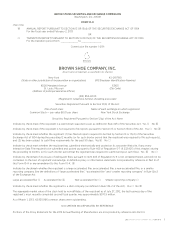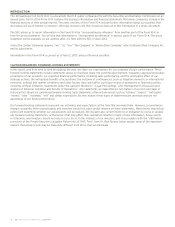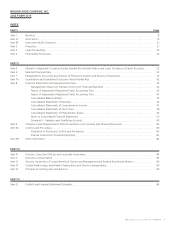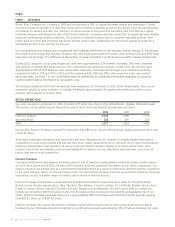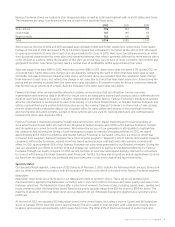Famous Footwear 2012 Annual Report Download - page 17
Download and view the complete annual report
Please find page 17 of the 2012 Famous Footwear annual report below. You can navigate through the pages in the report by either clicking on the pages listed below, or by using the keyword search tool below to find specific information within the annual report.
2012 BROWN SHOE COMPANY, INC. FORM 10-K 15
ITEM 1A RISK FACTORS
Economic conditions have adversely impacted, and may continue to adversely impact, consumer demand for our products.
Over the last several years, worldwide economic conditions deteriorated in many countries and regions, including the
United States. Despite some positive trends throughout 2012, business conditions may remain uncertain for the foreseeable
future due in part to cautious consumer spending. Consumer confidence and spending are strongly influenced by general
economic conditions, including U.S. fiscal policy, changing tax and regulatory environment, interest rates, inflation,
consumer debt levels, the availability of consumer credit, the liquidity of consumers’ assets, health care costs, currency
exchange rates, taxation, gasoline prices, real estate values, foreclosure rates, unemployment trends and the economic
consequences of military action or terrorist activities. Negative economic conditions generally decrease disposable income
and, consequently, consumer purchases of discretionary items like our products. Negative trends in economic conditions
also drive up the cost of our products, which may require us to increase the price of our products. These increases in our
product costs, and possibly prices, may not be oset by comparable increases in consumer disposable income. As a result,
our customers may choose to purchase fewer of our products or purchase the lower-priced products of our competitors,
and our business, results of operations, financial condition and cash flows could be adversely aected.
If we are unable to anticipate and respond to consumer preferences and fashion trends and successfully apply new
technology, we may not be able to maintain or increase our net sales and earnings.
The footwear industry is subject to rapidly changing consumer demands and fashion trends. Our products must appeal
to a broad range of consumers whose preferences cannot be predicted with certainty and are subject to rapid change.
Accordingly, the success of both our wholesale and retail operations depends largely on our ability to anticipate,
understand and react to changing consumer demands and preferences. Our performance athletic and outdoor footwear
brands are subject to additional challenges related to rapid changes in footwear technology, the availability of high quality
endorsers and the possibility of negative expert opinions on the unique technologies and designs of our performance
footwear brands. If we fail to successfully anticipate and respond to changes in consumer demand and fashion trends,
develop new products and designs and implement eective, responsive merchandising and marketing strategies and
programs, we could experience lower sales, excess inventories and lower gross margins, any of which could have an adverse
eect on our results of operations and financial condition.
We operate in a highly competitive industry.
Competition is intense in the footwear industry. Certain of our competitors are larger and have greater financial, marketing
and technological resources than we do; others are able to oer footwear on a lateral basis alongside their apparel products;
and others have successfully branded their trademarks as lifestyle brands, resulting in greater competitive advantages to
those competitors. Low barriers to entry into this industry further intensify competition by allowing new companies to
easily enter the markets in which we compete. In addition, retailers aggressively compete on the basis of price, which puts
competitive pressure on us to keep our prices low. Some of our suppliers further compound these competitive pressures by
allowing consumers to purchase their products directly through supplier maintained Internet sites and retail stores.
We believe that our ability to compete successfully in the footwear industry depends on a number of factors, including
style, price, performance, quality, location and service as well as the strength of our brand-names. We remain competitive
by increasing awareness of our brands, improving the eciency of our supply chain and enhancing the style, comfort,
fashion and perceived value of our products. However, our competitors may implement more eective marketing
campaigns, adopt more aggressive pricing policies, make more attractive oers to potential employees, distribution
partners and manufacturers, or respond more quickly to changes in consumer preferences than us. As a result, we may
not be able to compete successfully in the future, and increased competition may result in price reductions, reduced
gross margins, loss of market share and an inability to generate cash flows that are sucient to maintain or expand the
development and marketing of our products, which could adversely impact our financial results.
Our operating results depend on preparing accurate sales forecasts and properly managing our inventory levels.
Using sales forecasts, we place orders with manufacturers for some of our products prior to the time we receive all of our
customers’ orders to minimize purchasing costs, the time necessary to fill customer orders and the risk of non-delivery.
We also maintain an inventory of certain products that we anticipate will be in greater demand. However, the global
economic slowdown and rapidly changing consumer preferences can make it dicult for us and our customers to
accurately forecast product trends in order to match production with demand. If we fail to accurately assess consumer
fashion tastes and the impact of economic factors on consumer spending or to eectively dierentiate our retail and
wholesale oerings, our inventory levels may exceed customer demand, resulting in inventory write-downs, higher carrying
costs, lower gross margins or the sale of excess inventory at discounted prices, which could significantly impair our financial
results. Conversely, if we underestimate consumer demand for our products or if our manufacturers fail to supply the
quality products that we require in a timely manner, we may experience inventory shortages. Inventory shortages may
delay shipments to customers (and possibly require us to oer discounts or costly expedited shipping), negatively impact
retailer and distributor relationships, adversely impact our sales results and diminish brand awareness and loyalty.


